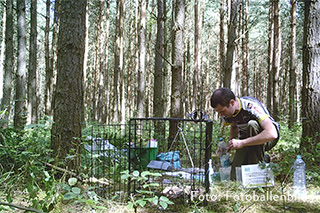Effect of habitat parameters on the decomposition rate of red deer cadavers in relation to cadaver visitor biodiversity in insects, wildlife and microorganisms (bacteria and fungi)
Motivation:
Cadavers are veritable hotspots for biodiversity of soil bacteria and fungi, bacteria and fungi both on and in the cadaver (necrobiome), and scavenging wild animals. Species which would never normally be found using randomly distributed floor traps in the forest can be found in surprising diversity and density on a large exposed mammal cadaver. On grounds of aesthetics and veterinary law, cadavers are very rarely, or never, left free to nature. If cadavers are removed as quickly as possible it inevitably affects the biodiversity of their visitors. This is the reason why the national park is conducting research on this crucial decomposer diversity. Researching the long term decomposition of animal biomass by means of year round cadaver availability completes the areas existing long term research on the breakdown of plant biomass, namely deadwood.
Project goals::
Wir möchten herausfinden, welchen Einfluss exponierte Kadaver auf die potentielle Besucherdiversität (Bakterien, Pilze, Insekten und aasfressende Wildtiere) haben. Im Fall von Mikroorganismen (Bakterien, Pilze) stellen wir uns die Frage, welche Habitatparameter im direkten Kadaverumfeld einen Einfluss auf deren Diversität haben und welcher Unterschied dabei im Vergleich zu kadaverfreien Standorten besteht. Zudem interessiert uns ein „störungsbedingter“ Langzeiteffekt auf die Bodenmikroorganismen und die Isotopensignatur, wenn ein längerfristiges Kadaverangebot (Langzeitluderplätze) besteht. Für Insekten und aasfressende Wildtiere möchten wir herausfinden, welche Habitatparameter im direkten Kadaverumfeld einen Einfluss auf deren Diversität haben und welcher Unterschied dabei im Vergleich zu kadaverfreien Standorten besteht. Dieses analoge Vorgehen garantiert eine gute Vergleichbarkeit mit den Ergebnissen der Mikroorganismen.
Study design:
Extension of the existing bait sites (2015), with the additional considerations of insect, bacteria and fungus diversities, as well as the temperature and humidity in the cadavers’ immediate surroundings. Standardized soil sampling will be conducted for fatty acid analysis in order to estimate the microbial biomass and the amount of soil microorganism groups under the effect of the different disturbance parameters. Furthermore, oral mucosa smear sampling will be used to identify the change in bacterial and fungal diversity during decomposition.
Finanzierung:
- Nationalparkverwaltung Bayerischer Wald
Contact person::
Dr. Christian von Hoerman
Scientific employee
Christian.vonHoerman@npv-bw.bayern.de
Prof. Dr. Marco Heurich
Head of department
Marco.Heurich@npv-bw.bayern.de
Collaborators:
- Prof. Dr. Liliane Rueß (Humboldt-Universität zu Berlin)) fatty acid analysis from soil material
https://www.biologie.hu-berlin.de/de/gruppen/oekologie_portal - Prof. Dr. Jörg Overmann (Leibnitz Institut DSMZ in Braunschweig) for next generation sequencing of bacteria and fungi
https://www.dsmz.de/research/microbial-ecology-and-diversity-research/scientific-staff.html - Prof. Dr. Krzysztof Szpila (Nikolaus Copernicus Universität in Toruń, Polen)) insect identification (blowflies and fleshflies)
https://www.keib.umk.pl/krzysztof-szpila/?lang=en
Publications:
- Südwest Presse: Warum Kadaver in naturnahen Wäldern schneller verrotten
https://www.swp.de/ulm/lokales/ulm_neu_ulm/Warum-Kadaver-in-naturnahen-Waeldern-schneller-verrotten;art1222880,4022525 - Deutschlandfunk: Nach sechs Tagen erstes Ferkel skelettiert
https://www.deutschlandfunk.de/forensik-nach-sechs-tagen-erstes-ferkel-skelettiert.676.de.html?dram:article_id=366878 - Stiegler J. (2017) Succession and use of carrion by scavenger communities in the Bavarian Forest National Park, master thesis
- von Hoermann C., Jauch D., Kubotsch C., Reichel-Jung K., Steiger S., Ayasse M. (2017) Effects of forest habitat structure and land use on the diversity of carrion visiting silphid beetles (Coleoptera: Silphidae): a large scale carrion study, Plos ONE, submitted
- Pascual J., von Hoermann C., Rottler-Hoermann A-M., Nevo O., Geppert A., Sikorski J., Huber K. J., Steiger S., Ayasse M., Overmann J. (2017) Function of bacterial community dynamics in the formation of cadaveric semiochemicals during in situ carcass decomposition, Environmental Microbiology, doi:10.1111/1462-2920.13828



